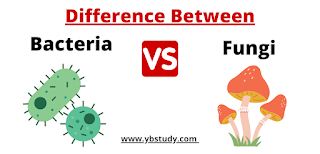5 Key Differences Between Bacteria and Fungi
According to scientists, millions of species of living beings currently live on our planet. Given their individual characteristics: body structure, life characteristics, habitats, genetic material, reproduction, and many others, taxonomists divide living organisms into kingdoms.
Here, In this article, we explain the differences between bacteria and fungi.
Similarities Between Bacteria and Fungi
The similarities between fungi and bacteria are as follows:
- Both are Living organisms.
- Fungi and bacteria have a cellular structure
- Fungi and bacteria have cytoplasm, cytoplasmic membrane, and ribosomes.
- Both organisms fungi and bacteria has a cell wall
- Both feed on ready-made organic substances, absorbing substances from the entire surface of the cell (we are talking about heterotrophic bacteria and fungi).
- Their cells have a similar structure.

Bacteria vs Fungus Major Differences
| Bacteria | Fungi |
|---|---|
| They are single-cell prokaryotic organisms without membrane-bound cell organelles. | They are multicellular eukaryotic organisms with membrane-bound cell organelles. |
| In bacteria nucleus is absent | Nucleus is present |
| The bacterial cell wall is composed of peptidoglycan. | A fungal cell wall is composed of chitin. |
| They reproduce through asexual reproduction– Binary fission | They reproduce either asexual or sexual reproduction. |
| Bacteria are motile. They can move through flagella | They are non-motile. |
| They obtain energy from sugars, proteins, and fats. | They obtain energy from the used and pre-existing sources present in an environment. |
| Bacteria need a host to grow. | They grow on their own. |
| Bacteria are heterotrophs but some bacteria are autotrophs eg. Photosynthetic bacteria. | Fungus is heterotrophs, usually feeding on the dead and decayed matter. |
| Bacteria have different shapes such as Rod – Bacillus, Round – cocci, and Spiral – Spirella. | They are thread-like structures known as hyphae but vary in shape. |
| Examples of bacteria are Lactococcus, Escherichia coli, Staphylococcus, Mycobacterium, etc | Examples of fungi are rusts, yeasts, molds, stinkhorns, truffles, and mushrooms. Brewer’s yeast, White button mushroom |
Read: Taq DNA Polymerase – Definition, Role and Limitations of Taq Polymerase
5 Key Differences Between Bacteria and Fungi
Bacteria and fungi both have many differences in terms of biological types, structures, sizes, proliferation methods, and names:
1. Different types of organisms:
- Bacteria do not have a nucleus surrounded by a nuclear membrane and they belong to prokaryotes; Fungi have a nucleus surrounded by a nuclear membrane and belong to eukaryotes.
- Bacteria are all composed of single cells and are unicellular organisms; Fungi have both unicellular organisms (such as yeast) composed of a single cell and multicellular organisms (such as edible fungi, molds, etc.) consisting of multiple cells.
2. The cell structure is different:
- Bacteria and fungi both have cell structures and belong to cell-type organisms. They both have cell walls, cell membranes, and cytoplasm in their cell structures, but there are many differences, specifically:
- First, the composition of the cell wall is different: the main component of the bacterial cell wall is peptidoglycan, while the main component of the fungal cell wall is chitin.
- Second, the composition of organelles in the cytoplasm is different: bacteria have only one organelle, the ribosome; while fungi have various organelles such as endoplasmic reticulum, Golgi apparatus, mitochondria, and centrosome in addition to ribosomes.
- The third is that bacteria do not have a nucleus, they have only nucleoids while fungi have a nucleus.
- Fourth, bacteria do not have chromosomes, and their DNA molecules exist alone, DNA in the nucleus of fungi is combined with proteins to form chromosomes (chromatin).
3. Cells vary in size:
- Bacterial cells are generally small, generally, 1 μm to 10 μm in diameter while fungal cells are more significant, generally 10 μm to 100 μm in diameter.
4. The reproduction methods are different:
- Bacteria reproduce through the unique method of binary fission while different species of fungi have different ways of reproduction such as budding (such as yeast) and sporogenesis (edible fungi).
Read: Cyanobacteria : Definition, Structure, Appearance, Importance, FAQs
What is Bacteria?
- Bacteria are prokaryotic, unicellular organisms that can only be seen under a microscope.
- Bacteria do not have a nucleus, In place of the nucleus, they have a nucleoid.
- Bacterial cells do not have membrane-bound cell organelles such as mitochondria, plastids, endoplasmic reticulum, etc.
- Bacteria multiply every 20-30 minutes by asexual reproduction methods.
- They can exist singly or form groups that resemble long chains, bunches of grapes, or coffee beans.
- They have different shapes such as cocci, bacilli, vibrio, spirilla, etc.
- Bacteria may be Phototrops, autotrophs, or heterotrophs. Autotrophs – can synthesize organic substances on their own, Heterotrophs – use ready-made organic substances.
- The importance of bacteria is they fix atmospheric nitrogen, promote soil formation, use wastewater treatment, cause water to bloom, and antibiotics, vitamins, and food products are obtained from them.
- Bacteria can cause infectious diseases.
What is Fungi?
- Fungi are eukaryotic multicellular or unicellular organisms. Yeast is unicellular, while mold and mushroom (large fungus) belong to multicellular fungi.
- More than 70,000 species of fungi have now been discovered, and it is estimated that only a fraction of all existence.
- Fungi can also cause a variety of diseases in animals, plants, and humans.
- Fungi, like bacteria and microbes, are decomposers, that is, organisms that break down the organic matter of dead organisms.
- Fungi decompose organisms into various inorganic substances, which enhance soil fertility.
- Other fungi are used in food processing, such as yeast for bread and other processing, and brewing also requires fungi.
- In agriculture, forestry, and animal husbandry, fungi have a harmful side.
- Fungi can cause a variety of plant diseases, resulting in huge economic losses.
